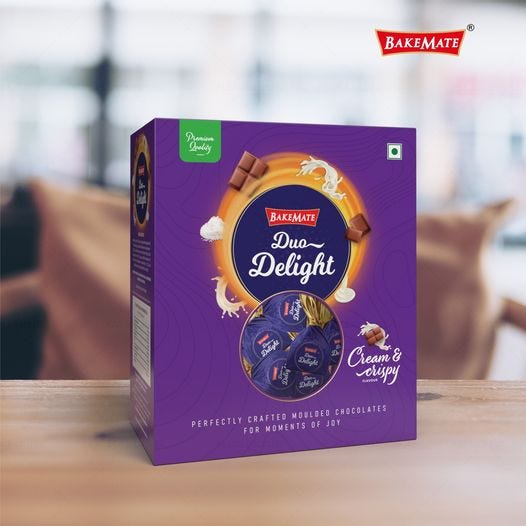Bakemate Biscuits are known for their variety and quality, often including flavours like chocolate, vanilla, and fruit-filled options. They might come in different forms, such as crunchy biscuits, cream-filled varieties, or even savory snacks. Bakemate typically offers a range of biscuits, including varieties like cream-filled, butter cookies, and savory snacks. Their products often emphasize quality ingredients and may cater to different dietary preferences.
Bakemate (Global Chocolate Manufacturers) biscuits are likely part of a range of baked goods offered by the brand, emphasizing quality ingredients and various flavors. Here’s an overview of what you might find with Bakemate biscuits:

1. BakeMate Chocolate Chips
- Purpose: Chocolate chips are a staple ingredient in many baked goods, such as cookies, cakes, and brownies. They are small and hold their shape when baked, offering a nice melt-in-your-mouth texture.
- Varieties: These may come in different types of chocolate:
- Milk chocolate chips
- Dark chocolate chips
- White chocolate chips
- Semi-sweet chocolate chips (for balanced sweetness)
- Uses: Great for cookies, muffins, cakes, and as a topping for various desserts.
2. Melting Chocolate
- Purpose: Specifically designed for easy melting and dipping, often used in candy-making or to coat fruits, nuts, and cookies.
- Varieties: This might include milk chocolate, dark chocolate, or even specialty chocolates designed for smooth melting.
- Uses: Great for making chocolate coatings, melting for ganaches, or simply dipping fruits like strawberries or bananas.
Quality & Features of BakeMate Products (Assumed):
- High-Quality Ingredients: As with most baking products, BakeMate would aim to use premium ingredients that provide great flavor and texture in your baked goods.
- Suitable for All Skill Levels: The products would likely be designed to be easy to use for both amateur bakers and experienced pastry chefs.
- Wide Availability: If this is a store-brand or regional brand, BakeMate chocolates could be found in local grocery stores, baking supply shops, or online retailers.
Chocolate comes in a wide array of flavors, and these variations are often created by adjusting the types of cocoa, ingredients, or adding flavor infusions. Here’s a breakdown of some of the most popular and unique chocolate flavors that you can encounter:

1. Classic Chocolate Flavors
These are the traditional chocolate types, and the flavors come primarily from the proportion and type of cocoa used.
- Milk Chocolate:
- Flavor: Creamy, sweet, and smooth with a mild cocoa flavor.
- Ingredients: Cocoa solids, milk powder (or condensed milk), sugar, and cocoa butter.
- Uses: Common in candy bars, milk chocolate chips for baking, and desserts like mousses and fondues.
- Dark Chocolate (Bittersweet, Semi-Sweet, or Unsweetened):
- Flavor: Rich, deep cocoa flavor with varying levels of bitterness depending on the cocoa content. It has less sugar than milk chocolate, which gives it a more intense flavor.
- Ingredients: Cocoa solids, sugar, cocoa butter, and sometimes vanilla or lecithin as an emulsifier.
- Uses: Great for baking (cookies, cakes), ganaches, or paired with fruits like strawberries or oranges.
- White Chocolate:
- Flavor: Sweet and creamy with a buttery, milky flavor. No cocoa solids, so it lacks the characteristic bitterness of dark chocolate.
- Ingredients: Cocoa butter, milk solids, sugar, and vanilla.
- Uses: Popular in candies, confections, and as a coating for cookies or fruit.
- Ruby Chocolate:
- Flavor: A fruity, tart, and berry-like flavor due to the natural properties of the specially processed cocoa beans.
- Ingredients: Similar to milk chocolate but with a higher percentage of red cocoa beans that impart a distinct color and taste.
- Uses: Candies, bars, and novelty chocolate desserts.
2. Flavored and Infused Chocolates
Beyond the basic chocolate types, many chocolatiers and brands infuse chocolate with various ingredients to create unique flavours.
- Mint Chocolate:
- Flavor: A refreshing combination of cool, crisp mint and rich chocolate.
- Uses: Common in chocolate bars, ice cream, and after-dinner mints.
- Orange Chocolate:
- Flavor: A zesty, citrusy flavour that complements the deep bitterness of dark chocolate.
- Uses: Dark chocolate and orange are a classic pairing in candies and cakes.
- Hazelnut Chocolate:
- Flavor: A sweet, nutty flavor that comes from roasted hazelnuts blended with chocolate.
- Uses: Popular in spreadable forms (like Nutella), chocolate bars, and truffles.
- Almond Chocolate:
- Flavor: Nutty, with a bit of crunch. Almonds add a slightly sweet and savory flavor to chocolate.
- Uses: Found in chocolate bars, chocolate-covered almonds, and truffles.
- Caramel Chocolate:
- Flavor: Rich, sweet, and slightly buttery with a chewy texture, balanced by the smoothness of the chocolate.
- Uses: In chocolate bars, filled chocolates, or drizzled over desserts.
- Coffee Chocolate:
- Flavor: A rich, bitter flavor from coffee beans, complementing the cocoa’s richness.
- Uses: Popular in chocolate bars, ganaches, or hot chocolate.
5. Gourmet Chocolate Flavors
Some specialty chocolate makers experiment with more unusual ingredients to create bold and distinctive flavors.
- Coconut Chocolate:
- Flavor: Tropical and sweet with the richness of coconut paired with chocolate.
- Uses: In chocolate bars, coconut truffles, and chocolate-covered coconut candies.
- Peanut Butter Chocolate:
- Flavor: Creamy, nutty, and salty peanut butter combined with chocolate, often in a ratio that makes the peanut butter a prominent flavor.
- Uses: In candies, bars, or peanut butter-filled chocolates.
· For more details contact https://bakemate.in
· Email: enquiry@bakemate.in

